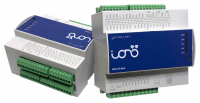Difference between revisions of "IonoPiMax"
| Line 125: | Line 125: | ||
|dualsdsync.status | |dualsdsync.status | ||
| − | | | + | |N |
|R | |R | ||
|status of the last SD synchronisation run: | |status of the last SD synchronisation run: | ||
Revision as of 18:25, 5 January 2021
Iono Pi Max is an extremely versatile industrial server with a huge variety of Input/Output lines and standard communication interfaces, all routed to the incredibly powerful quad-core processor of the Raspberry Pi.
This driver provides support for a local installation of HSYCO on Iono Pi Max itself. The Raspberry Pi OS Kernel module for Iono Pi Max must be installed. The kernel module documentation is available at GitHub and the Iono Pi Max User Guide.
Contents
HSYCO Configuration
Add a IONO Pi Max I/O Server in the I/O Servers section of the Settings and set its parameters:
High Availability
- Shutdown when inactive: defaults to false.
Options
| ID | Default | Values | Description |
|---|---|---|---|
| startupevents | false | true | generate IO events also during the driver’s start-up phase |
| false | start generating events only after HSYCO is aligned with the current status of the system | ||
| pollinterval | 250 | 10 <= n <= 30000 | the data acquisition interval, in milliseconds |
| watchdog | always | always | enables the hardware watchdog and automatically generates the heartbeat signal (when the HSYCO main control loop is running normally, approximately every 10 seconds). The watchdog timeout is set to 60 seconds while HSYCO is running, or to 1 hour when HSYCO is manually stopped (sysctl stop hsyco) and when it is starting |
| true | enables the hardware watchdog only while HSYCO is running, and automatically generates the heartbeat signal (when the HSYCO main control loop is running normally, approximately every 10 seconds). The watchdog timeout is temporarily set to 1 hour when HSYCO is starting | ||
| false | disables the hardware watchdog | ||
| ignore | doesn't change the watchdog configuration parameters | ||
| shutdown_minutes | 0 | 0 | no automatic shutdown after power failure |
| N > 0 | the driver will command the operating system shutdown and hardware power off after N minutes of back-up battery operations during a power failure. Iono Pi Max will be turned back on when power is restored | ||
| quiet | false | true | enables audible alarms on power failure |
| false | disables audible alarms on power failure |
Datapoints
The Iono Pi Max implements all data points provided by the underlying Iono Pi Max kernel module. Refer to the documentation is available at GitHub.
Each readable file name exposed by the kernel module under the /sys/class/ionopimax/ sub-directories appears as a data point with id <subdir>.<file>. For example, as the buzzer's status file is /sys/class/ionopimax/buzzer/status, the corresponding data point is "buzzer.status".
Command files that are marked as write only in the documentation (W), are not shown as visible data points in HSYCO, but can be used in the IO events action or ioSet() methods to send a command.
For example, if "max" is the id assigned to the Iono Pi Max I/O Server, then:
TIME : IO max.buzzer.beep = 1000
will make the buzzer beep for 1 second (1000 ms).
Note that "max.buzzer.beep" is not visible in the Status Browser and doesn't generate events, because it is write only, and only the "max.buzzer.status" data point will be visible, with a value of 0 if the buzzer is not active, or 1 if active.
Additional datapoints
| ID | Value | R/W | Description |
|---|---|---|---|
| shutdown | 1 | W | initiate a power cycle |
| dualsdsync | 0 | R | manual SD synchronisation completed |
| 1 | R | manual SD synchronisation pending or in progress | |
| W | initiate SD synchronisation (only available when the dualsdsync option is set to "manual" | ||
| dualsdsync.status | N | R | status of the last SD synchronisation run:
|
Release Notes
3.8.0
- dual µSD card support
- improved watchdog and UPS support
3.7.0
- initial release
Iono Pi Max is a registered trademark of Sfera Labs Srl
